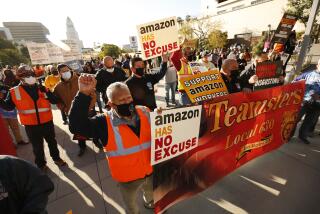The High Cost of Infighting at Work
- Share via
Competition for scarce resources and recognition is so intense in many companies that employees often spend more time competing with each other than working together, a management authority says.
Unfortunately, “The focus of people arguing is on their own agenda rather than on the agenda of the organization,” said Abigail Hubbard of the University of Houston.
“If you don’t focus on your unit and yourself, in essence you are punished because you don’t get sufficient resources to survive,” Hubbard said of such workplaces.
Much internal strife is generated by company “forced ranking” plans--when employees are rated against each other. This means that employees “must have an evaluation higher than their colleagues’ if they are to be the ones retained during cutbacks,” Hubbard said.
“We find forced ranking is very common, particularly in your larger corporations,” said Steven Frohman, president of Applied Synergistics in Milwaukee. “It’s an excellent example of setting up a competitive environment you don’t want.
“A lot of innovative companies are focusing on the team rather than the individual and look to team members to self-select, self-evaluate and self-develop,” he said.
Bristol-Myers Squibb Co. “has given a lot of thought” to fostering employee cooperation, public affairs manager Donna Jakubowski said. Its training center “encourages employees to share information and to realize how they can accomplish greater things together than working individually.”
Larry Ferree, vice president for human resources at Express Personnel Services in Oklahoma City, said some managers think that if they can get their subordinates “competing with each other, then the sum total of the productivity is going to be enhanced. It’s a mistaken idea.”
*
Competitive behavior, he said, “creates friction and it makes the workplace less enjoyable.” Ferree faults management for this because employees “don’t embark on it unless they think they will benefit as a result.”
The message that employees get from management “might be purely in the reward system, when they see the individual who blows their horn the loudest driving into the parking lot in their convertible. If they see the most aggressive employee is rewarded, the others will think, ‘That’s what I’ve got to do to get ahead,’ ” Ferree said.
To quell employee infighting, Hubbard said, managers must “be careful that the symbols they create in terms of language stress cooperation instead of internal competition.”
They must stop employees “from referring to staffers in other units of their own company as ‘you people’ or worse, and from using the same aggressive language [toward colleagues] they use toward competitors, such as, ‘We’re going to kill those guys,’ ” Hubbard said.
“It shouldn’t be ‘my project’ and ‘my people.’ That sounds medieval, like ‘I’m the knight and you’re the serf.’ It should be ‘us,’ especially if we want to foster a team environment,” she said.
Another positive step is to employ cross-functional work teams to break up the “clan-type” mentality that crops up where employees are “organized by functions with allegiance to their professional group at the subunit level,” Hubbard said.
Professionals such as design engineers, accountants, or architects commonly work in such tightly knit groups that their common bonds “promote internal thinking, rather than strategic, organizationwide thinking,” Hubbard said.
Human resources officials can promote harmony by making employees understand how they will be evaluated and rewarded.
“It will transfer the focus from the subunit to the organization as a whole, and that will diminish the infighting,” Hubbard said.
She concludes that leaders’ “behavior has to be congruent with the values that they espouse. Then if they ‘walk the talk,’ it makes it safe for everyone else to emulate their behavior.”
More to Read
Inside the business of entertainment
The Wide Shot brings you news, analysis and insights on everything from streaming wars to production — and what it all means for the future.
You may occasionally receive promotional content from the Los Angeles Times.










